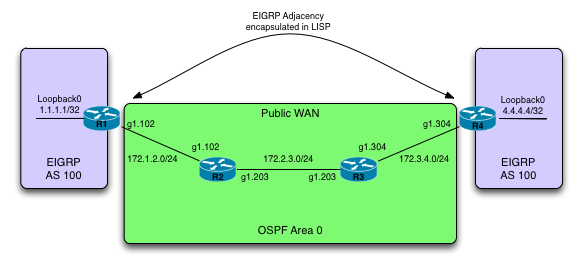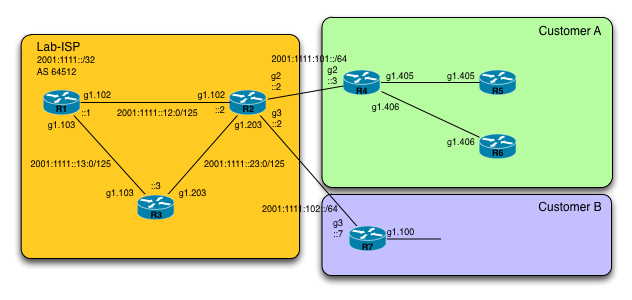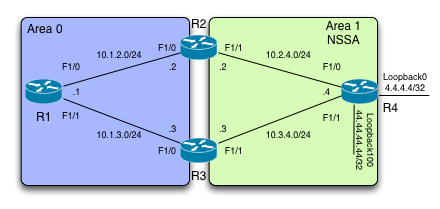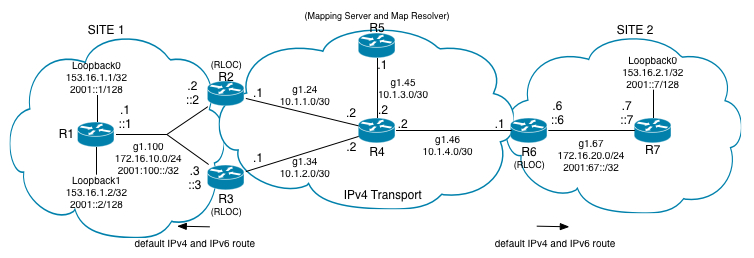Its a new year!
My apology. I have been very absent here as of late.
I have been doing some different stuff, which is irrelevant here, but rest assured, i got some posts lined up. The next one on Unified MPLS. I think you will like it, so stay tuned! ![]()
Happy New Year! ![]()
Cisco Champion.
Woke up to a very nice email today.
I have been selected as a Cisco Champion for 2015! – Now i get to see what all the fuzz is about and hopefully be able to contribute something.
EIGRP OTP example
In this post id like to provide an example of a fairly new development to EIGRP which is called EIGRP Over The Top (OTP).
In all its simplicity it establish an EIGRP multihop adjacency using LISP as the encapsulation method for transport through the WAN network.
One of the applications of this would be to avoid relying on the SP in an MPLS L3 VPN. You could simply use the L3 VPN for transport between the interfaces directly connected to the Service Provider and run your own adjacency directly between your CPE routers (without the use of a GRE tunnel, which would be another method to do it)
The topology used for this example consists of 4 routers. All 4 of the routers are using OSPF to provide connectivity (you could take this example and do a L3 VPN using MPLS as an exercise). Im simply taking the lazy path and doing it this way ![]()
R1 and R4 are running EIGRP in a named process “test”. This process is in Autonomous system 100 and the Loopback 0 interfaces are advertised into the V4 address-family.
Lets verify that we have connectivity between R1’s g1.102 interface and R4’s g1.304 Continue reading
A bit of maintenance
I am currently performing a bit of maintenance on the blog (moving host), so there might be some small errors here and there. I apologise for this! – Hopefully everything will be up and running smoothly in a few days time.
Thank you for your patience!
/KP
Trying out IPv6 Prefix Delegation
In this post i will show how and why to use a feature called IPv6 Prefix Delegation (PD).
IPv6 prefix delegation is a feature that provides the capability to delegate or hand out IPv6 prefixes to other routers without the need to hardcode these prefixes into the routers.
Why would you want to do this? – Well, for one is the administration overhead associated with manual configuration. If the end-customer only cares about the amount of prefixes he or she receives, then it might as well be handed out automatically from a preconfigure pool. Just like DHCP works today on end-user systems.
On top of that, by configuring a redistribution into BGP just once, you will automatically have reachability to the prefixes that has been handed out, from the rest of your SP network.
So how do you go about configuring this? – Well, lets take a look at the topology we’ll be using to demonstrate IPv6 Prefix Delegation.
First off, we have the SP core network which consists of R1, R2 and R3. They are running in AS 64512 with R1 being a BGP route-reflector for the IPv6 unicast address-family. As an IGP we are running OSPFv3 to provide Continue reading
VRF based path selection
In this post I will be showing you how its possible to use different paths between your PE routers on a per VRF basis.
This is very useful if you have customers you want to “steer” away from your normal traffic flow between PE routers.
For example, this could be due to certain SLA’s.
I will be using the following topology to demonstrate how this can be done:
A short walkthrough of the topology is in order.
In the service provider core we have 4 routers. R3, XRv-1, XRv-2 and R4. R3 and R4 are IOS-XE based routers and XRv-1 and XRv-2 are as the name implies, IOS-XR routers. There is no significance attached to the fact that im running two XR routers. Its simply how I could build the required topology.
The service provider is running OSPF as the IGP, with R3 and R4 being the PE routers for an MPLS L3 VPN service. On top of that, LDP is being used to build the required LSP’s. The IGP has been modified to prefer the northbound path (R3 -> XRv-1 -> R4) by increasing the cost of the R3, XRv-2 and R4 to 100.
So by default, traffic between Continue reading
Using the OSPF Forwarding Address for traffic-steering
In this fairly short post, id like to address a topic that came up on IRC (#cciestudy @ freenode.net). Its about how you select a route thats being redistributed into an OSPF NSSA area and comes into the OSPF backbone area 0.
For my post i will be using the very simple topology below. Nothing else is necessary to illustrate what is going on.
First off, id like to clarify a few things about what takes place when redistributing routes into an NSSA area.
What happens is that you have an external network, 4.4.4.4/32 in our example. This is _not_ part of the current area 1. When this network is being redistributed into area 1, its forwarding address will be set to the highest active interface of the redistributing router in the area (R4 in our case). The highest interface in the area local to the router is Loopback100 with an address of 44.44.44.44/32.
*A reader noted that a loopback address will beat a physical interface even if it has a lower address. This is true and goes for OSPF in general. Thanks!
Lets verify the configuration on R4 and the result of Continue reading
Using LISP for IPv6 tunnelling.
In this post I would like to show how its possible to use a fairly new protocol, LISP, to interconnect IPv6 islands over an IPv4 backbone/core network.
LISP stands for Locator ID Seperation Protocol. As the name suggest, its actually meant to decouple location from identity. This means it can be used for such cool things as mobility, being VM’s or a mobile data connection.
However another aspect of using LISP involves its tunneling mechanism. This is what I will be using in my example to provide the IPv6 islands the ability to communicate over the IPv4-only backbone.
There is alot of terminology involved with LISP, but i will only use some of them here for clarity. If you want to know more about LISP, a good place to start is http://lisp.cisco.com.
The topology i will be using is a modified version of one presented in a Cisco Live presentation called “BRKRST-3046 – Advanced LISP – Whats in it for me?”. I encourage you to view this as well for more information.
Here is the topology:
Some background information about the setup. Both Site 1 and Site 2 are using EIGRP as the IGP. Both IPv4 and Continue reading
EIGRP Query bounding.
In the process of restudying EIGRP as a protocol, and more specifically as to how it converges, you can’t avoid running into the saying “Remember to bound your queries!”.
From a conceptual point of view its fairly easy to understand that the further out you ask for a prefix the longer the convergence process will take. But what really takes place when you have different tools in place to bound the query from taking place?
There are 3 different types of “Query Bounding” techniques that can be utilized:
1) Filters (fx. distribute lists).
2) Summarization
3) Stub routers.
How do they actually work to limit the query scope?
Well, the basic premise for EIGRP queries is the fact that you are asking your fellow EIGRP neighbour for an exact prefix, fx. 172.16.1.0/25. If for any reason you EIGRP neighbour does not have this in his topology table, it will simply respond right away that it doesn’t have a path to this prefix. Query stopped right there.
By using filters such as distribute lists you are removing the prefix from ever getting advertised to the neighbour and as such he will never receive it in his topology Continue reading
Change of focus
I have decided to change my focus quite a bit.
I was planning on tackling the IOS-XR exam this year and was preparing for it by going through the blueprint. However another track kept pulling me towards it, and ofcourse thats the CCDE track.
I have spent the last 6 years learning how to do something, but so far i havent spent alot of time thinking about why that is.
I am not doing the CCDE track in order to pass the exam. I might not even go as far as giving the practical exam a go. I am however going to pursue the written exam for now, as it will give me a target for which to learn new stuff.
To that end, a few of us have created a study group, which im very thrilled about. It will provide an outlet for any ideas and thoughts as well as input. All in all great stuff.
So thats a quick update ![]()
CRS/ASR Switching fabrics
At the moment I’m going through whitepapers, Cisco Live 365 presentations and IOS XR fundamentals learning about switching fabrics.
Its a steep learning curve, but in its own way its quite fascinating.
There are a lot of acronyms to be mastered, so later on i will post a list that might serve myself and others when looking at these sort of architectures.
Whats next…
I have a lot of non-technical related projects in the pipeline, but study wise, whats next up for me is the IOS XR specialist exam.
I think the blueprint for it looks interesting and it provides a way for me to learn more about IOS XR.
I don’t really have a date for the exam just yet as I’m taking it easy and trying to lab out as much as i can to have it stick.
I will be posting about anything i find interesting or different from Classic IOS. Right now I’m trying to figure out the details on the LPTS implemented on XR platforms. A way of protecting the management/control plane of the router.
Take care!
Passed the CCIE SP Lab exam.
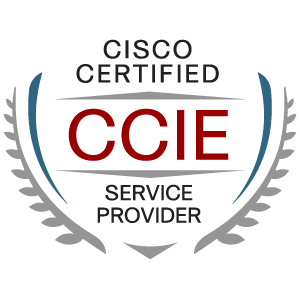 Well, a short update. I managed to pass the CCIE Service Provider lab exam on March 14th.
Well, a short update. I managed to pass the CCIE Service Provider lab exam on March 14th.
I am quite exhausted from the experience, but very happy ![]()
ESXi Server Build
With the release of the IOS XRv router, along with CSR (Cloud Services Router), its time that I go ahead and build myself a virtualization solution.
To that effect, I have just ordered the components for a home build server, which was the cheapest, not to mention most silent option available.
The components are:
Intel Xeon 3.2 Ghz processor (E3-1230).
32 Gig of memory.
Intel Micro ATX server motherboard (S1200V3RPL).
A 120 Gig Kingston SSD.
A supposedly silent PSU.
And to house it all, a Lian-Li Micro-ATX cabinet (PC-V300B).
Hopefully, everything will be here next week. Looking forward to it ![]()

